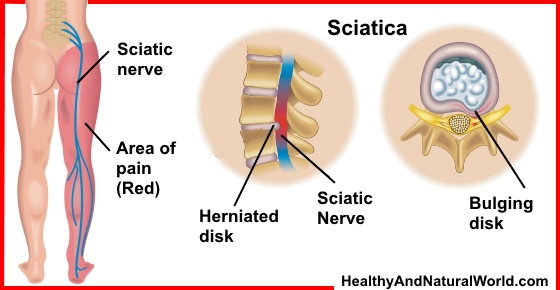Top 8 Natural Treatments For Sciatic Pain

The sciatic nerve is one of the largest nerves of our body. It runs all the way down from the lower spine over the buttock to both feet to provide movement, feeling, and strength in both legs.
As many as 40% of all people will suffer from sciatic pain at some point in their life. This is a condition which is often mistaken for lower back pain or leg cramps. But it actually is something that puts pressure or pinches the nerve and fires pain down your back or thigh to your legs.
Sciatic pain can vary from a mild ache or numb feeling to a sharp, burning and very painful sensation that occurs off and on through one side of your body. Most people stay in bed and take ibuprofen or other over the counter painkillers to find relief.
Here are 8 natural ways that could help you to cure the inflammation and fight sciatic pain.
1. Acupuncture
Acupuncture is an alternative treatment were hair-fine needles are inserted at specific points of your body. It stimulates energy flow and improves nerve function. Some people get relief after just one session, but for most people it takes a few sessions.2. Chiropractor
Although the effectiveness of chiropractic adjustments shows mixed scientific results, many sciatic patients report a significant reduction in sciatic pain.Spinal manipulation can restore the mobility, improve function, reduce inflammation, decrease the pain, and promote natural healing.
3. Ice Packs
Ice packs (or a package of frozen peas wrapped in a towel) work great to find instant relief. Apply for 20 minutes on the affected area every two hours until pain disappears.4. Alternate Temperatures
Although ice packs work great to find instant relieve, the sciatic nerve lies deep within our body and ice packs won’t go down to the inner inflammation.Apply a hot pack, just after icing or take a very hot bath. Alternate temperatures boost blood circulation and lymph flow, which can help you to reduce inner inflammation and assist the healing process.
5. Mild (Yoga) Stretches
Moving around may be the last thing on your mind when struggling with sciatic pains, but it is important to get physically active or the pain will last longer.Inactivity actually aggravates the problem. Some people report improvements through gentle back or yoga stretches. These exercises increase blood flow, strengthen the back muscles, and improve mobility.
Alternatively you can walk to stretch your leg and back muscles.
6. Massage
Deep tissue massage or trigger-point therapy has shown some beneficial effects on muscle spasms, pain, and numbness of legs and toes.Use herb infused oil or add essential oils to enhance the effect.
7. Tennis Ball Therapy
Tennis ball therapy utilizes the principles of massage, acupressure and reflexology which help to relieve sore muscles and muscle tension.In the case of sciatic pain, the tennis ball aims to treat the piriformis muscle which is located close to the sciatic nerve. This muscle can push the sciatic nerve against the tendons beneath it, which results in contributing to the familiar buttock and leg pain.
The tennis ball presses and treats trigger points in the piriformis muscle, reduces the muscle tension and rigidity, improves mobility and improves blood circulation to the area.
8. Epsom Salt Bath
Epsom salts are known to relax the nervous system and draw toxins out of your body, and can be found in any local drug store.Fill the bath with hot water and add 2 cups of Epsom salt. Soak in the bath for about 15-20 minutes. The heat of the bath will also increase circulation and reduce inflammation.
And last but not least, give your nerves and body time to heal, relax, and balance.
So get some extra sleep and rest to give your nerves the chance to rebuild and strengthen themselves.
Although most of these complementary and alternative remedies are not backed up by scientific studies, many people report significant improvements and it helps control the pain, spasm, numbness, and cramps.
If the pain and symptoms persist, it is important to visits a doctor to see if there is a dislocated vertebrate or any other condition that pinches or puts pressure on your nerves. Sometimes a surgery is needed to put everything back in place.